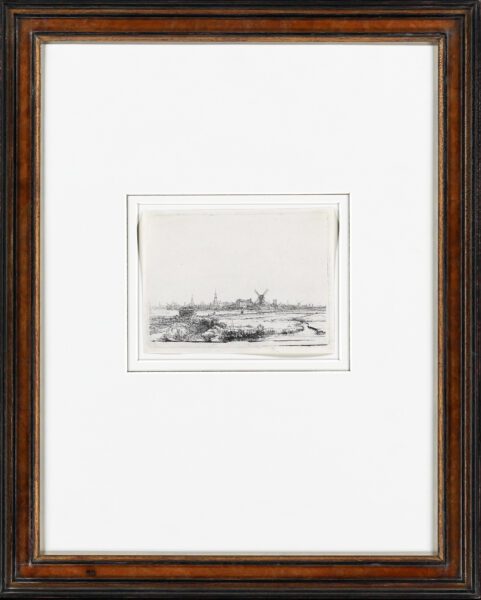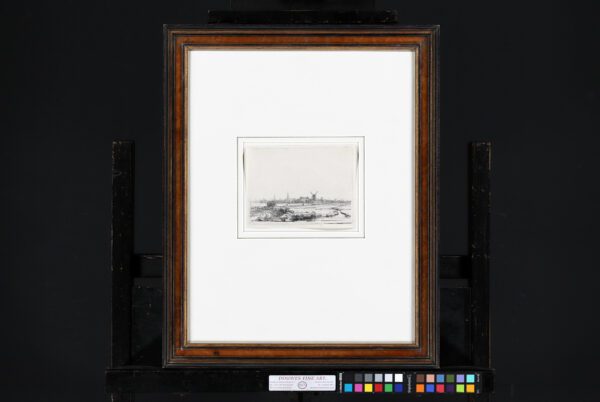“View of Amsterdam from the Kadijk”, c. 1641
etching: 12,4 x 16,3 cm;
watermark Foolscap with five-pointed Collar (Hinterding K.a.)
with small margins
"*" indicates required fields
Notes
During his lifetime, Rembrandt’s extraordinary skills as a printmaker were the main source of his international fame. Unlike his oil paintings, prints travelled light and were relatively cheap. For this reason, they soon became very popular with collectors not only within, but also beyond the borders of the Netherlands.
This is a fine example of Rembrandt’s famous view of Amsterdam, a remarkably compact and yet expansive view of the city from afar, with its church spires, many windmills at the edge of town and the large, looming warehouse of the Dutch East India Company in the middle. The skyline of the city itself occupies only a narrow strip of the print, while two thirds of the plate are left blank, to convey the vastness of the sky. The lower third is taken up by the marshlands outside of the city, with the reeds along the canals as dark accents, leading the eye towards the many buildings on the horizon. Rembrandt’s vantage point is the Kadijk, the dyke on the north-eastern edge of Amsterdam, yet the panorama is not an accurate depiction of the city but rather an atmospheric rendition. The fact that the view from here is shown in reverse may indicate that Rembrandt drew it on the spot, directly onto the plate. Had he worked from a preparatory drawing, it seems plausible that he would have reversed the image when transferring it onto the printing plate. Some authors have, however, argued that Rembrandt took some liberties with the actual topography, and saw this as an indication that he manipulated the view in the studio, rather than drawing directly onto the plate what he saw.
Literature
Bartsch 210; Hind 176;
The New Hollstein, 2013, no. 203: only state
Plate not in existence – with Nowell-Usticke (1967): R – A scarce print
Provenance
- Domingo Guillermo de Arozarena (circa 1860), probably Havana and Paris (Lugt 109);
- his posthumous sale, Hôtel Drouot, Paris (exp. Clément),11-16 March 1861, lot 697 (‘Très-belle épreuve; elle a une petite marge’) (Fr. 87; to Roth).
- David Didier Roth (circa 1798-1885), Paris (without mark; see Lugt 2172);
- his sale, Hôtel Drouot, Paris (exp. Clément), 1-6 December 1879, lot 365 (‘Très-belle épreuve, avec une petite marge. Collection Arozarena’) (Fr. 261; to Clément).
- Wilhelm Eduard Drugulin (1825-1879), Leipzig (Lugt 2612); possibly acquired from or through Clément.
- With E. & R. Kistner, Nuremberg.
- Private Collection, Switzerland;
- acquired from the above in 1995 (DM 48,000); then by descent.
- Christie’s London
- Private Collection, The Netherlands
A fine impression of this important landscape printing clearly and strongly, with good contrasts and depth.





